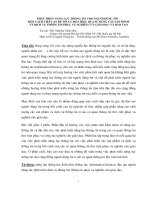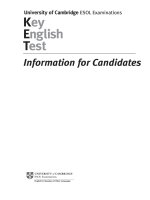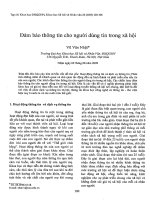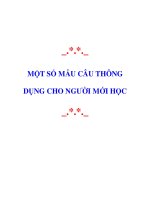Information For Candidates Flyers (Thông tin cho người dự thi Flyers)
Bạn đang xem bản rút gọn của tài liệu. Xem và tải ngay bản đầy đủ của tài liệu tại đây (1.63 MB, 12 trang )
University of Cambrid
g
e ESOL Examinations
Young
Learners
English
Flyers
Information for Candidates
yle flyers information for candidates 2
What does YLE Flyers involve?
This booklet is a brief introduction to YLE Flyers. We show examples from each part of
the test, but in some cases we do not show the full text or all of the questions. If you
would like to see full sample papers for YLE Flyers, you can download them from our
website at:
www.CambridgeESOL.org/support/dloads/yle_downloads.htm
There is a defined set of vocabulary and structures for each level of YLE and you should
make sure that you are familiar with the vocabulary and structures you need to know
for YLE Flyers. This list of grammar and structures and a list of vocabulary (in
alphabetical order) is also available from our website.
The table below shows the different parts of YLE Flyers and how long each paper takes.
■ Listening
approx. 25 minutes/25 questions
There are five parts in the Listening test. You hear all the parts of the test twice. In the
test, all the parts include an example.
Information for
candidates –
YLE Flyers
Name of paper Number of parts Number of questions Time allowed
Listening 5 parts 25 questions approx. 25 minutes
Reading and Writing 7 parts 50 questions 40 minutes
Speaking 4 parts – 7–9 minutes
Dear Parent
Thank you for encouraging your child to learn English and to take this YLE
(Young Learners English) Flyers test.
We believe that learning English should be fun and stimulating for children
and we hope it will also be interesting for you to watch your child grow in
confidence as he or she learns more and more English. Taking a test such as
YLE Flyers is an excellent way of motivating your child to learn and showing
how much progress he or she has made.
We have prepared this booklet to give you and your child a brief introduction to
the different parts of YLE Flyers and the type of questions you can expect to
find. We hope you will take the time to read the booklet together with your
child and that it will give you a clear picture of what we expect children to be
able to do in English when taking YLE Flyers.
Young Learners English tests come to you from Cambridge ESOL (English for
Speakers of Other Languages) which is part of Cambridge Assessment, a
department of the world-famous University of Cambridge in the UK. So, you
can be sure that we have created a test you can trust which will help your child
to do his or her very best at English.
We hope you enjoy preparing for and taking YLE Flyers!
With best wishes
Cambridge ESOL
yle flyers information for candidates 3
Part 1 (5 questions)
In Part 1 you see a big picture which shows different people doing different things. There
are seven names round the picture. You hear an adult and a child talking about the
people in the picture. You have to draw a line from the name you hear to the correct
person in the picture. We have done an example for you. Can you see the line from
William? In the test, there are three more people you have to find.
Part 2 (5 questions)
In Part 2 you hear a conversation between two speakers. On the question paper there is
a form or a page on a notepad. You have to write a word or a number in five places on
the form or notepad. You do not have to spell words perfectly if they are not spelled out
for you. In the conversation below, a woman is asking a man about his children’s sports
club. In the test there are three more questions like these.
Katy Harry William Sarah
Richard Michael Helen
This is what you hear …
Can you see the line? This is
an example. Now you listen
and draw lines.
Man: Who’s the boy just behind
William?
Girl: There are two boys just behind
him. Which one do you mean?
Man: The one with dark hair. He’s
coming second in the race now.
Girl: Oh, that’s Harry. He’s very good
at running, too.
Man: Look at all the silver cups on
the table.
Girl: Yes, they’re ready for the teams
that win.
Man: Who’s the older boy? – look,
he’s sitting next to the table.
Girl: That’s Michael. He’s won lots of
cups for running. He’s going to
give the cups to the children
that win.
This is what you hear …
Now you listen and write.
Woman: Is it near here?
Man: Yes! It’s next to the
chocolate factory.
Woman: Oh. I know it. That’s good!
Man: Yes, the children like the
smell.
Woman: OK. So when can children
use the club? I mean, which
days?
Man: Well, it’s open for everyone
from Friday to Tuesday. It’s
closed on Wednesdays and
Thursdays.
Part 3 (5 questions)
In Part 3 you have two sets of pictures. On the left hand page of the exam paper there
are some pictures of named people or other named places or objects. On the right hand
side is a set of pictures with letters but no words. You hear a conversation between two
people and you have to match one of the lettered pictures to one of the named pictures.
You write a letter in each box beside the named pictures.
Have a look at the pictures below. What did each person in Mr Salt’s family choose to buy
in the new supermarket? In the test, there are two more people to match to objects.
This is what you hear …
Girl: Have you been to that new supermarket in town, Mr Salt?
Man: Yes, I took all the family there last week to do some shopping. It sells all kinds of
things – clothes, food, things for the car, sports things. I even found a very nice
dark blue suitcase there. It wasn’t expensive so I bought it to use on our next
holiday.
Girl: Did anyone else buy anything?
Man: Well, David. He’s my oldest son – he’s nineteen. He wanted a volleyball so he
went to look at all the sports things first. He found one and he bought it. There
were a lot of other things that he wanted, too, so he’ll go there again another day.
He’ll have some more money soon.
Girl: You’ve got a daughter too, haven’t you?
Man: I’ve got two! The older one is called Betty. She just loves clothes and she found
some shorts which she liked a lot. They were too big for her, but she still bought
them because she loved the colour. She’ll have to wear a belt with them, I think.
yle flyers information for candidates 4
yle flyers information for candidates 5
Part 4 (5 questions)
In Part 4 you hear five connected dialogues. There is a question about each dialogue and
you have to choose which of three pictures gives the answer to the question. You must
put a tick (✓) in the box below the correct picture. In the test, you have three more
questions like the ones below.
Part 5 (5 questions)
In Part 5 you see a big picture like the one on the next page. You listen to a dialogue
between an adult and a child and must colour specific objects using the colour that we
tell you to use. You will also have to draw and colour a simple object and to write a short
word somewhere in the picture.
1 What should David put on the desks?
A
B C
2 Which is Daisy’s desk?
A
B C
This is what you hear …
One
Woman: Would you like to help me?
Boy: Yes please.
Woman: Can you put some bottles of
glue on all the desks, and
some scissors, too, please.
Boy: OK. And paints?
Woman: No, not today.
Tw o
Woman: Daisy left her dictionary in
the library. Can you put it
on her desk, please?
Boy: Yes, but which is her desk?
Woman: It’s that one, near the door.
Boy: This one?
Woman: No, there’s a bin under
Daisy’s desk.
yle flyers information for candidates 6
The picture below shows a scene at an airport. In the test, there are three more
dialogues like the ones on the left of the picture and three more objects to colour.
■ Reading and Writing
40 minutes/50 questions
There are seven parts in the Reading and Writing test. In the test, all the parts include at
least one example. You do not have to write much but you must take care to spell all
your answers correctly.
Part 1 (10 questions)
In Part 1 you look at fifteen words and ten definitions. You must find the word which
matches each definition and write it beside its definition. There are no pictures to help
you in this part. In the test, there are five more questions like the ones below.
This is what you hear …
Can you see the woman’s
blue hat? This is an
example. Now you listen
and colour and write and
draw.
One
Boy: What shall I colour now?
Woman: Let’s see. Can you see the
children over there?
Boy: Yes I can. There are three
children who are all sitting
down.
Woman: Well, look at the boy on the
right. He’s wearing glasses.
Boy: Yes. Shall I colour that boy’s
hair brown?
Woman: OK.
Tw o
Woman: Can you see the bags?
There are two on the left of
the picture, near the boy
with the drink.
Boy: Shall I colour one?
Woman: No, write on the bigger one.
Write the word ‘golf’ on it.
yle flyers information for candidates 7
Part 2 (7 questions)
In Part 2 you look at a big picture and read seven sentences about it. Some of the
sentences describe the picture correctly and some do not. If the sentence says
something true about the picture, then you write ‘yes’ beside that sentence. If what the
sentence says about the picture is not true, then you write ‘no’ beside the sentence.
Part 3 (5 questions)
In Part 3 you read a short conversation between two people. Everything that the first
speaker says is in the right order. The second speaker’s answers are in a separate box
and you have to choose A, B, C, D or E for each gap. You must write the letter of the
correct answer in the gap. In the test, there are two more questions like the ones below.
Questions
1 The time on the round clock is
quarter past nine. _______
2 The woman who is talking on the
telephone is also holding a
newspaper. _______
3 The woman with a baby has got
a fan in her hand. _______
4 A boy is putting an empty bottle
into the bin. _______
5 One of the men in the café is
wearing black shorts. _______
6 The door which is nearer to the
plant is closed. _______
7 The man in the uniform has got a
green flag in his hand. _______
A Yes, she did.
B Yes, that’s right!
C OK. She’d like that!
D I don’t know. It’s difficult to choose.
E He had one last year.
yle flyers information for candidates 8
Part 4 (6 questions)
In Part 4 you read a text which has five gaps in it. The missing words may be nouns,
adjectives or verbs. Next to the text there is a box with words in it. You choose the
correct word from the box and copy it into each gap. For the last question (6), you must
choose the best title for the text from a choice of three possible titles.
Part 5 (7 questions)
In Part 5 you read a story.There is a picture which illustrates the story and seven
sentences about it. You must complete the sentences, using one, two, three or four
words. The pictures may help you to understand the story but do not give you the
answers to the questions. In the test the story is longer and there are four more
questions like the ones below.
example
month sleep sleeping
outside closed bowl
ran torch opened
(6) Now choose the best name for the story.
Tick one box
Tiger goes to a hotel
Tiger’s dinner party
Tiger runs away
Emma’s favourite doll
My name is Betty and I have
a little sister called Emma.
She has lots of dolls, but her
favourite one is called Daisy.
Mum and Dad gave it to her
when she was a baby and
she takes it everywhere with
her. She takes it to school
and to her bedroom and
when we sit down to eat, the doll always sits next to Emma.
Last Sunday, our family went to the park to have a picnic. We took our dog,
Treasure, with us and of course, Emma took Daisy too. There were a lot of people
in the park because it was sunny. We found a place near the lake to have our
picnic. After lunch, Emma and I went on the swings. After a few minutes, Emma
said to me, ‘Betty, I want Daisy on the swing with me. Can you go and get her for
me?’ ‘OK!’ I answered . . .
Questions
1 Emma got the doll when she
________________.
2 Daisy always sits
________________ Emma when
she eats.
3 The family had a
________________ in the park
on Sunday.
My aunt went on holiday last _______________ but she couldn’t
take her cat, Tiger, to a hotel with her, so he stayed with us. My
aunt gave us some food for Tiger and Mum put it in the hall. Most of
the time, Tiger enjoyed (1) _______________ in our garden, but at
dinner time he always came into the hall to eat. On Saturday after-
noon, Mum said to me, ‘Can you give Tiger his food today because I
have to go out?’ ‘Of course, Mum,’ I answered and at five o’clock I
went (2) _______________ to call him. ‘Tiger! Tiger! Time to eat!’
But he didn’t come. I wanted to watch a TV programme in the living
room so I (3) _______________ a window for Tiger to come in. Ten
minutes later, I heard something strange and I (4) _______________
into the hall. When I got there, Tiger and three other cats from our
street were all eating their dinner from his (5) _______________ !
month
yle flyers information for candidates 9
Part 6 (10 questions)
In Part 6 you read a factual text which has ten gaps. The gaps are for grammar words like
prepositions, pronouns, adverbs and verbs. You have a choice of three words to fill each
gap and must choose the correct word and copy it into the gap.
Part 7 (5 questions)
In Part 7 you read a text from a letter or a diary. The text has five gaps. You must write a
word in each gap. There is no list of words to help you. There are some pictures which
will help you understand the text but they will not give you the answers to the
questions. This part of the test tests your knowledge of both grammar and vocabulary.
■ Speaking
7–9 minutes/4 parts
In the Speaking test someone, perhaps your own teacher, will explain the test to you in
your own language. That person will then take you into the exam room and will
introduce you to the examiner.
The examiner will give you marks for understanding what he or she says, for responding
appropriately in English, for grammar and vocabulary and for pronunciation.
Part 1
First the examiner will greet you and will ask you your name. Then the examiner will
give you one picture and show you that he or she has a picture which is similar but has
yle flyers information for candidates 10
some differences. The examiner will read you some sentences about his or her picture
and you must look at your picture and explain how it is different. For example, the
examiner might say ‘In my picture there’s a puppy behind the tree.’
Part 2
In Part 2 you and the examiner take turns to ask and answer questions based on a pair
of similar pictures and question prompts. First the examiner will ask you questions
about your picture and then you must ask similar questions about the examiner’s
picture.
yle flyers information for candidates 11
Part 3
In Part 3 the examiner will show you five pictures which tell a story. The examiner tells
you about the first picture and then asks you to continue the story. The examiner might
say, for example, ‘It’s David’s birthday. He’s very excited. His friends have come to his
party. His mother, father and baby sister are there too.’ You must then talk about the
other four pictures.
Part 4
In Part 4 the examiner will ask you some questions about yourself. He might ask you, for
example, about your school, your hobbies, your birthday, your family or your holidays.
Preparing for Flyers
If you would like more practice material to help you prepare for the revised YLE Flyers
exam, past paper packs, including an audio CD of the Listening test (published by
Cambridge University Press) will be available in late 2006. You can find more
information, prices and details of how to order on our website at:
www.CambridgeESOL.org/support/pastpapers.htm
Next steps
We wish you every success in taking Flyers and we hope that you will take other
Cambridge ESOL exams in future. The Key English Test (KET) is a test at a similar level to
YLE Flyers but for older students, or if you do well at Flyers you could consider the
Preliminary English Test (PET) as your next step. You can find more information about
KET and PET on our website at:
www.CambridgeESOL.org/exams/ket.htm
or
www.CambridgeESOL.org/exams/pet.htm
University of Cambridge
ESOL Examinations
1 Hills Road
Cambridge
CB1 2EU
United Kingdom
Tel. +44 1223 553355
Fax. +44 1223 460278
© UCLES 2006 EMC | 3698 | 6Y07 NOT FOR RESALE
www.CambridgeESOL.org/YLE
What do I get after I take the test?
When you take a Young Learners English test, you get an award from Cambridge ESOL
showing how well you have done in each part of the test – Listening, Reading and
Writing and Speaking.
For each part of the test you get one or more Cambridge shields (up to a maximum of
five, so you could get a total of 15 shields for the whole test if you do really well!). Below
is a picture of the award which shows you and your family how well you have done.









